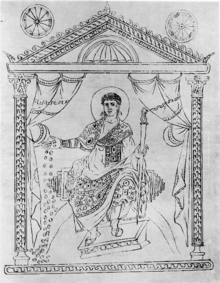Largitio
As Largitio (Latin for "generosity") donations and gifts are in Roman designated time belonged to a socio-political system.
Giver
In addition to persons of official life, private individuals also appear as donors. In addition to money and material goods, gifts can also include gifts with a social character such as dinner. In the course of the Roman Empire , the nature of the largitions changed. In late antiquity , these are often gifts from the emperor or high officials. For the area of imperial gifts the z. B. Notitia Dignitatum mentioned comes sacrarum largitionum responsible, a senior official with the rank of vir illustris .
Gift recipients and occasions
Similar to the donations of the early and middle imperial period, soldiers and officers received gifts that were intended to ensure their support and loyalty. Senior officials were also given similar consideration. In the case of the attributes of the comes sacrarum largitionum in the Notia Dignitatum, for example, bowls filled with money are depicted. Such so-called largition bowls are preserved several times in late antique treasures . Inscriptions such as on the Decennial plate of Constans from the silver treasure of Kaiseraugst indicate that they were presented on the occasion of government anniversaries. On the missorium of Theodosius I , which was given away for the tenth anniversary of his reign after the inscription, such a largition scene is presumably depicted: The emperor enthroned in the center of the picture hands an object to a kneeling soldier or official, probably one due to the damage to the plate not sure recognizable gift. Other occasions are also conceivable, for example the depiction of a victorious, riding emperor on a silver plate from Kerch may indicate that the piece was given away after a war.
The gifts
The gifts can be of considerable material value. In the case of the silver largition bowls, for example, the weight and thus the material value is often stated by the workshops on the back. So on the Theodosius missorium a weight of 50 Roman pounds is given. In addition, the prestige that such an item could convey as an expression of an imperial favor is to be assessed highly. Largition gifts can also come from other areas. So some wear as Emperor brooches called golden onion knob fibulae also imperial jubilee inscriptions; these were also given as official gifts. See also multiple aureus and multiplum .
literature
- Wilhelm Enßlin : Largition. In: Paulys Realencyclopadie der classischen Antiquity Science (RE). Volume XII, 1, Stuttgart 1924, Col. 835f.
- Martin Guggisberg , Annemarie Kaufmann-Heinimann (ed.): The late Roman silver treasure from Kaiseraugst. The new finds. Research in Augst August 34, 2003.

